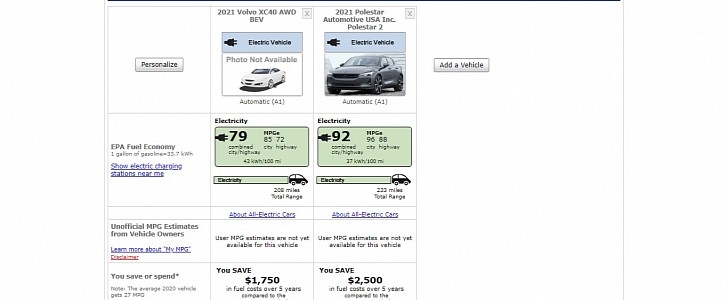Fresh from publishing the 233-mile driving range of the Polestar 2, the Environmental Protection Agency has recently uploaded the numbers for the XC40 Recharge. The all-electric crossover from Volvo is similarly disappointing where it matters, promising 208 miles (335 kilometers) from a 78-kWh battery.
With an energy consumption of 43 kilowatts-hour per 100 miles, the XC40 Recharge also happens to be less efficient than the Hyundai Kona (27 kWh) and comparable rivals. To make matters worse, we don’t know if the all-new crossover will be good value because pricing information has yet to be announced.
The only piece of intel we’ve got is “less than $48,000” after including the $7,500 federal tax credit for electric vehicles, translating to $55,000 or thereabouts. For reference, the Tesla Model Y is five grand less for the dual-motor powertrain with the Long Range battery pack that promises 316 miles (509 kilometers).
With all due respect, Volvo has to step up its game if the Swedish automaker intends to challenge traditional automakers that offer EVs and Tesla. 17 percent more energy consumption than the Polestar 2 is woeful by all accounts, not just for a compact crossover. Even the BMW i3 does better in terms of efficiency, and I’m not surprised given that the i3 was developed as an EV from the bottom up while the XC40 Recharge is based on the Compact Modular Architecture.
The SEA – short for Sustainable Experience Architecture – may turn things around for the better but it will be a slow burn. Geelyunveiled this platform last month, and production is scheduled to start in 2021 with a Lynk & Co model. Volvo is understood to adopt these underpinnings by 2025 with the XC20.
On an ending note, those in the market for an eco-friendly Volvo are better off with the plug-in hybrid Twin Engine powertrain options. The XC40 Recharge T5, for example, is much obliged to return up to 29 miles (46 kilometers) of all-electric range under the Worldwide Harmonized Light Vehicle Test Procedure.
The only piece of intel we’ve got is “less than $48,000” after including the $7,500 federal tax credit for electric vehicles, translating to $55,000 or thereabouts. For reference, the Tesla Model Y is five grand less for the dual-motor powertrain with the Long Range battery pack that promises 316 miles (509 kilometers).
With all due respect, Volvo has to step up its game if the Swedish automaker intends to challenge traditional automakers that offer EVs and Tesla. 17 percent more energy consumption than the Polestar 2 is woeful by all accounts, not just for a compact crossover. Even the BMW i3 does better in terms of efficiency, and I’m not surprised given that the i3 was developed as an EV from the bottom up while the XC40 Recharge is based on the Compact Modular Architecture.
The SEA – short for Sustainable Experience Architecture – may turn things around for the better but it will be a slow burn. Geelyunveiled this platform last month, and production is scheduled to start in 2021 with a Lynk & Co model. Volvo is understood to adopt these underpinnings by 2025 with the XC20.
On an ending note, those in the market for an eco-friendly Volvo are better off with the plug-in hybrid Twin Engine powertrain options. The XC40 Recharge T5, for example, is much obliged to return up to 29 miles (46 kilometers) of all-electric range under the Worldwide Harmonized Light Vehicle Test Procedure.






























